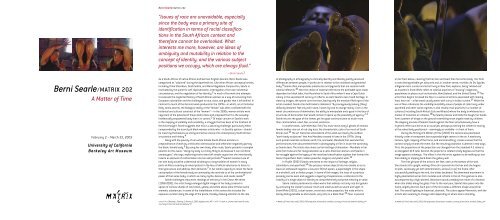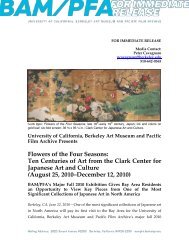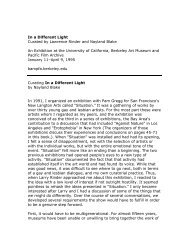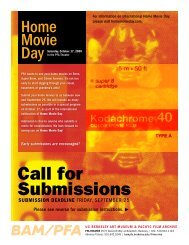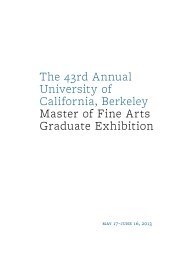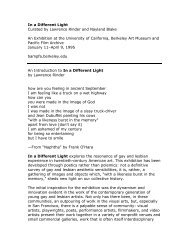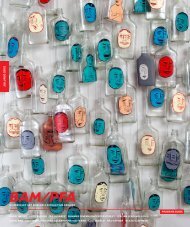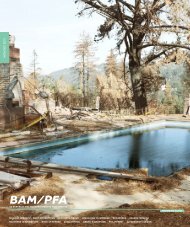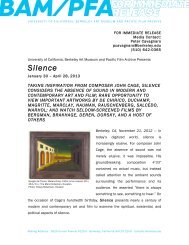Berni Searle - Berkeley Art Museum and Pacific Film Archive ...
Berni Searle - Berkeley Art Museum and Pacific Film Archive ...
Berni Searle - Berkeley Art Museum and Pacific Film Archive ...
You also want an ePaper? Increase the reach of your titles
YUMPU automatically turns print PDFs into web optimized ePapers that Google loves.
<strong>Berni</strong> <strong>Searle</strong>/ M AT RIX 202“Issues of race are unavoidable, especiallysince the body was a primary site ofidentification in terms of racial classificationsin the South African context <strong>and</strong>therefore cannot be overlooked. Whatinterests me more, however, are ideas ofambiguity <strong>and</strong> mutability in relation to theconcept of identity, <strong>and</strong> the various subjectpositions we occupy, which are always fluid.”—<strong>Berni</strong> <strong>Searle</strong> 1<strong>Berni</strong> <strong>Searle</strong>/MATRIX 202A Matter of TimeFebruary 2 – March 23, 2003University of California<strong>Berkeley</strong> Ar t <strong>Museum</strong>As a South African of native African <strong>and</strong> German-English descent, <strong>Berni</strong> <strong>Searle</strong> wascategorized as “coloured” during the Apartheid era. Like other African conceptual artists,including Yinka Shonibare, Zineb Sedira, <strong>and</strong> María Magdalena Campos-Pon, <strong>Searle</strong> ismotivated by the quest for self-representation, interrogation of her own existentialcircumstance, <strong>and</strong> the negotiation of her identity. 2 In much of her work she attemptsto excavate the neglected history of South African women as a way of recovering fromEuropean colonialism <strong>and</strong> the challenges to race, class, <strong>and</strong> gender that it left behind. Incontrast to much of the feminist work produced in the 1970s—in which, as art historianKelly Jones asserts, the biological reality of the “female” was often conflated with thehistorical <strong>and</strong> cultural construct of the “woman”— in the 1990s, women artists werecognizant of the potential of these distinctions <strong>and</strong> proposed that it is the sexually/intellectually empowered body that is in control. 3 Of major concern in <strong>Searle</strong>’s workis the mapping of visibility <strong>and</strong> invisibility, a struggle that has been at the forefront offeminist thought. <strong>Searle</strong> suggests that this is a daunting challenge, particularly whencompounded by the scarcity of black women artists who—in <strong>Searle</strong>’s opinion—shouldbe inserting themselves as strong <strong>and</strong> active voices into contemporary South Africanart practice <strong>and</strong> history. 4Along with the paucity of non-white female South African artists is apreponderance of work by artists who oversexualize <strong>and</strong> otherwise negatively portraythe black, female body. 5 By using her own body, often nude, <strong>Searle</strong> presents a complexposition on this issue. “Using my body is a tricky thing to do because it can reinforcestereotypes,” she says, explaining that to ward off simple voyeurism she intentionallyinserts an element of confrontation into her self-portraits. 6 <strong>Searle</strong>’s insistent use ofher own body could be understood to belong to a long tradition of women in manyparts of Africa resorting to naked protest in the face of official reluctance to listen totheir grievances <strong>and</strong> address their dem<strong>and</strong>s. 7 In her work’s capacity to resist the facileconsumption of the female body as commodity she reminds us of the confrontationalpower of that same body, in which so many myths, desires, <strong>and</strong> needs reside. 8<strong>Searle</strong> challenges reductivist readings of ethnicity. In her Colour Me series(1998-2000), the artist hangs enlarged digital images of her body covered inspices of various shades of red, brown, yellow, <strong>and</strong> white above piles of these samearomatic substances. In some of the installations in this series she includes theexposure number along the edge of the prints, thereby drawing attention to the roleof photography in ethnography to clinically identify <strong>and</strong> thereby justify perceiveddifferences between people, in particular in relation to the racialized <strong>and</strong> genderedbody. 9 <strong>Searle</strong> often manipulates substances <strong>and</strong> pigments that are resonant withcolonial referents. 10 Here the choice of material references the profitable spice trade,dependent on black labor, that flourished in South Africa when it was a Cape Dutchcolony in the seventeenth century; it reflects, as well, <strong>Searle</strong>’s own mixed heritage. Inclose-up images, the spices cover her face, leaving only the emotion-filled eyes of theartist revealed. <strong>Searle</strong> cites bell hooks’s statement: “By courageously looking (they)defiantly declared: ‘Not only will I stare, I want my look to change reality.’ Even in theworst circumstances of domination, the ability to manipulate one’s gaze in the face ofstructures of domination that would contain it opens up the possibility of agency.” 11<strong>Searle</strong> returns the gaze of the viewer, yet her gaze communicates so much morethan confrontation: need, fear, survival, existence.In another work, Julle Moet Nou Trek (You must move away), ghosts of ecstaticfemale bodies rise out of red clay dust, the characteristic color of so much of SouthAfrican soil. 12 The art historical antecedents of this work are clearly the outdoor“earth-body-sculptures” that Ana Mendieta created in Iowa in the 1970s. Usingsuch primal materials as blood, earth, fire, <strong>and</strong> water, Mendieta first executed herperformances, then documented them in photography or film in much the same wayas <strong>Searle</strong> does. The artists also share certain feelings of alienation—Mendieta in herexile from Cuba <strong>and</strong> her marginalization as a Latin American woman, <strong>and</strong> <strong>Searle</strong> inher struggle against the legacy of the racialized classification system that formed thebasis of apartheid. Each creates powerful, magical, <strong>and</strong> poetic work. 13In Profile (2002) <strong>Searle</strong> comments on the impact of heritage, religion,colonialism, <strong>and</strong> apartheid. 14 She presses various objects into her cheeks so as toleave an embossed negative: a souvenir British spoon, a paperweight in the shapeof a windmill, <strong>and</strong> an Arabic prayer. In some of the images, the trace of a previouspressing can be seen <strong>and</strong> suggests a layering of experiences, a reference to theinability of a single object or identity to comprehensively comprise meaning or value.<strong>Searle</strong> creates performance video works that address not only race but genderby activating the viewer’s senses: touch <strong>and</strong> smell as well as sound <strong>and</strong> sight. InSnow White (2001), a dual-screen, mural-size video projection, the nude artist isbarely distinguishable as she kneels, very still, on a black floor. 15 Flour is pouredon her from above, covering first her hair <strong>and</strong> head, then her entire body. Her formis now distinguishable yet obscured <strong>and</strong>, in another sense, invisible. As Olu Oguibe,a Nigerian-born curator <strong>and</strong> artist living in New York, explains, being “whited-out”as enacted in Snow White refers to colonial practices of “erasing” indigenouspopulations in places such as Australia, New Zeal<strong>and</strong>, <strong>and</strong> the United States. 16 Theartist then begins to knead the flour in a series of actions associated with makingfood, here roti – a flat bread usually eaten with curry in Indian cuisine. 17 While theuse of flour references the visibility/invisibility issue of people of color living underapartheid <strong>and</strong> other racist regimes, it also recalls ritual practices in a number ofcultures (including South Africa’s Zulu <strong>and</strong> Xhosa) where the body is whitened as amarker of transition or initiation. 18 As <strong>Searle</strong> presses <strong>and</strong> folds the dough, her h<strong>and</strong>sform a pattern of wings on the ground resembling snow angels made by children.The slapping sounds of <strong>Searle</strong>’s h<strong>and</strong>s against the floor simultaneously have arhythmic effect <strong>and</strong> serve as an aural jolt, perhaps punishing the viewer for staringat the naked body positioned— seemingly so available—in front of them.During the filming of A Matter of Time (2003) the camera was positioneddirectly under a transparent box suspended eight meters in the air. A stationarycamera, tight cropping of the frame, <strong>and</strong> minimal editing, create a sense that thecamera simply records the event. But the resulting projection is altered in two ways.First, the proportions of the projection are changed from the st<strong>and</strong>ard 4:3 ratios toan elongated 16:9 ratio. Second, the projector is rotated ninety degrees so that theimage appears sideways. The effect is that the artist appears to be walking up <strong>and</strong>then sliding or slipping back down the gallery wall.The first glimpse of the artist is her feet, seen at the bottom of the wall.She st<strong>and</strong>s still, upright, waiting. Olive oil in poured into the box <strong>and</strong> she beginsto walk, cautiously yet with determination, across (or up) the frame. Aftersuccessfully walking to the end, she slides backward. The downward movement ishighly abstracted as her form mutates <strong>and</strong> refracts in the oil. This gesture is alsoaccompanied by a high-pitched, dissonant sound, probably the result of a vibrationwhen she slides along the glass. Prior to the next pour, <strong>Searle</strong>’s face peers into theframe, slightly blurred. Each pour of the oil creates a different shape around herfeet. The overall lighting is theatrical, dramatic. The colors appear Mannerist, with theartist’s skin seeming to change color depending on where she is st<strong>and</strong>ing.COVER: (l to r) Resting 1, Resting 2, Resting 3; 2003; digital prints; 40 1 /2 x 47 1 /4 each in.; photo credit Jean Brundit;courtesy of the artist <strong>and</strong> Axis Gallery, NYA Matter of Time (video still), 2003; DVD projection; dimensions variable; courtesy of the artist <strong>and</strong> Axis Gallery, NYA Matter of Time (video still), 2003; DVD projection; dimensions variable; courtesy of the artist <strong>and</strong> Axis Gallery, NY
<strong>Searle</strong> chose to work with olive oil for many reasons, including itsconsumption, flavor, color, <strong>and</strong> sensuous quality. As the primary material of herperformance, the oil supplies a duality of beauty <strong>and</strong> danger. For <strong>Searle</strong>, there isan additional metaphorical significance: she wants control yet simultaneouslyplays with taboos—the attraction/revulsion relationship in self-representation,exoticization, <strong>and</strong> didacticism. The visual suggestion of tactility is extremely sensualin A Matter of Time. <strong>Searle</strong> uses her body <strong>and</strong> its inherent appeal to take a potentpolitical stance. The artist asserts her right to use <strong>and</strong> present her own body. It is adefiant, feminist gesture that refuses the assignment of any meaning other than onher own terms.In the moments between the passes that the artist makes across the glasssurface, the projected image is black, though hardly monochromatic. Streaks ofcolors appear in the blackness, subtle variations of shade <strong>and</strong> hue. Small bubblesin the oil catch light. As in the “black” paintings of Ad Reinhardt, the viewer’sperception of what is there alters upon close inspection. The black fields of colorare metaphors for the inherent failings in assigning one color or identity to anyindividual or group.In describing the process of making A Matter of Time, <strong>Searle</strong> relates thedifficulty of taking the first, untried step out onto the glass box. Subsequently,she says, an incredible suction occurred <strong>and</strong> it became difficult to pull away from.<strong>Searle</strong> explains that the slipperiness of the oil references the changing nature ofidentity.Part of the impetus for A Matter of Time was something that <strong>Searle</strong>’sgr<strong>and</strong>mother told her when she was a child: that one day she would travel to placeswhere people would appreciate the olive color of her skin. She believes that hergr<strong>and</strong>mother was telling her that there are places other than South Africa, wherethe color of her skin would not matter, where it would be considered beautiful, evenexotic. These words were intended not only to exp<strong>and</strong> the young <strong>Searle</strong>’s worldperspective, but also to promise hope. <strong>Searle</strong> states, “What I am drawn to, <strong>and</strong>what I appreciate, is the sentiment. It has nothing to do with reality.” 19 The issues<strong>Searle</strong> confronts—racial <strong>and</strong> gender inequity—are now widespread in visual <strong>and</strong>news media. <strong>Art</strong>ists such as Adrian Piper, Janine Antoni, Hannah Wilke, <strong>and</strong> LornaSimpson have also addressed them. Nevertheless, equality has yet to be achieved.It is essential to keep reminding the world that there is still more to be done, as wellas to ask others <strong>and</strong> ourselves why. Why does the notion that a place where thecolor of one’s skin does not matter have nothing to do with reality? And when will it?One hopes, perhaps unrealistically, that it is only a matter of time.Heidi Zuckerman JacobsonPhyllis Wattis MATRIX Curator1 <strong>Berni</strong> <strong>Searle</strong> in conversation with the author, via e-mail, December 29, 2002. 2 Salah M. Hassan,“: Self <strong>and</strong> Other in Contemporary African <strong>Art</strong>, “ Authentic/Ex-centric: Conceptualismin Contemporary African <strong>Art</strong> (Ithaca, NY: Forum for African <strong>Art</strong>s, 2001), p. 26. 3 Kellie Jones, “ Life’sLittle Necessities: Installations by Women in the 1990s,” Trade Routes: History <strong>and</strong> Geography.2nd. Johannesburg Biennale (Johannesburg: AICA: Africus Institute for Contemporary <strong>Art</strong>, a projectof the Greater Johannesburg Metropolitan Council, 1997), pp. 286-287. 4 Hassan, p. 31. 5 See OkwuiEnwezor, “Reframing the Black Subject: Ideology <strong>and</strong> Fantasy in South African Representation,”Reading the Contemporary: African <strong>Art</strong> from Theory to the Marketplace (Boston: MIT Press, 1999),pp. 376-399 for a more extensive analysis on this subject. 6 Barbara Pollack, “Feminism’s NewLook,” ARTnews, September 2001, vol. 100, no. 8, p. 136. 7 Annie E. Coombes, “Skin Deep/Bodies ofEvidence: The Work of <strong>Berni</strong> <strong>Searle</strong>,” Authentic/Ex-centric: Conceptualism in Contemporary African<strong>Art</strong>, p. 198. 8 Ibid. 9 Rory Bester, “Interview with <strong>Berni</strong> <strong>Searle</strong>,” The Field’s Edge: Africa, Diaspora,Lens (Tampa: Contemporary <strong>Art</strong> <strong>Museum</strong>, University of South Florida, 2002), n/p. 10 Coombes, p.188. 11 Hassan, p. 31. 12 Coombes, p. 188. 13 Susan S. Weininger, “Ana Mendieta,” Grove<strong>Art</strong>.com(Macmillan Publishers, Ltd. 1998-2002). 14 Bester, n/p. 15 The work was commissioned for theAuthentic/Ex-centric exhibition presented in conjunction with the 49 th Venice Biennale (2001) <strong>and</strong>was intended by the curators to counter the absence of African conceptual artists in large-scaleinternational survey exhibitions. 16 Pollack, p. 136. 17 <strong>Searle</strong> notes that this tradition was passeddown to her from her Mauritian great-gr<strong>and</strong>father, who was a cook. 18 Coombes, p. 197. 19 <strong>Berni</strong><strong>Searle</strong>, unpublished artist statement, 2002.<strong>Berni</strong> <strong>Searle</strong> was born in Cape Town, South Africa, in 1964. She received a Bachelor of <strong>Art</strong>s degreein Fine <strong>Art</strong> from the University of Cape Town in 1987 <strong>and</strong> a Master of <strong>Art</strong>s in Fine <strong>Art</strong> in 1995.<strong>Searle</strong> lives <strong>and</strong> works in Cape Town.Selected Solo Exhibitions2002 “<strong>Berni</strong> <strong>Searle</strong>,” Seippel Gallery, Cologne, Germany2001 “Still,” Axis Gallery, New York, NY“Colour Matters,” Kunsthalle Stadtgallerie, Osnabrück, Germany1999 “Colour Me,” Mark Coetzee Fine <strong>Art</strong> Cabinet, Cape Town, South AfricaSelected Group Exhibitions2002 “The Spice Route,” Institut für Ausl<strong>and</strong>sbeziehungen (IFA), Stuttgart, Germany“The Field’s Edge: Africa, Diaspora, Lens,” USF Contemporary <strong>Art</strong> <strong>Museum</strong>, Tampa, FL“Watching Ocean <strong>and</strong> Sky Together,” Liverpool Biennale, Liverpool, U.K.“Tracing the Rainbow,” Kunst:Raum Sylt-Quelle, Rantum, Germany; Kulturverein Zehntscheuer,Rottenburg/NeckarRottenburg, Germany“Fronteras,” Espacio C, Sant<strong>and</strong>er, Spain2001 “Authentic/Ex-centric: Africa In <strong>and</strong> Out of Africa,” 49th Venice Biennale, Venice, Italy“Encounters with the Contemporary,” Smithsonian National <strong>Museum</strong> of African <strong>Art</strong>, Washington, D.C.“Dis-Locations,” PHOTOESPANA2001, Madrid, Spain; Sala Rekalde, Bilbao, Spain; Centro Cultural DeMaia, Oporto, Portugal2000 “A.r.e.a. 2000,” Reykjavik <strong>Art</strong> <strong>Museum</strong>, Reykjavik, Icel<strong>and</strong>“L’<strong>Art</strong> dans le Monde,” Culée du pont Alex<strong>and</strong>re III, Paris, France“FNB Vita 2000,” S<strong>and</strong>ton Civic Gallery, Johannesburg, South Africa“DAK’ART 2000,” National <strong>Museum</strong>, Dakar, Senegal“Insertion,” Apex <strong>Art</strong>, New York, NY“Kwere Kwere: Journeys into Strangeness,” The Castle, Cape Town; Gertrude Posel Gallery,Johannesburg; <strong>and</strong> NSA, Durban, South Africa“Afrika Porträt,” House of World Cultures, Berlin, Germany1999 “Towards-Transit: New Visual Languages in South Africa,” De Blaue Saal, Zurich, Switzerl<strong>and</strong>“Lines of Sight: Perspectives on South African Photography,” South African National Gallery, CapeTown, South Africa“Bloodlines/Bloedlyn,” Klein Karoo Kunste Fees, Oudtshoorn, Western Cape, South Africa1998 “7 th International Cairo Biennale,” Cairo, Egypt1997 “Life’s Little Necessities,” 2nd Johannesburg Biennale, The Castle, Cape Town, South AfricaSelected Catalogues, Books, <strong>and</strong> PeriodicalsBedford, Emma. “What’s It Mean? The Cairo Biennale.” Co@<strong>Art</strong>snews, February 1999, p. 19.Coombes, Annie. “Skin Deep/Bodies of Evidence: The Work of <strong>Berni</strong> <strong>Searle</strong>,” in Authentic/Excentric:Conceptualism in Comtemporary African <strong>Art</strong>, Edited by S. Hassan <strong>and</strong> O. Oguibe. Ithaca,NY: Forum for African <strong>Art</strong>s, 2001, pp. 178-201.Lewis, Desiree. “The Conceptual Work of <strong>Berni</strong> <strong>Searle</strong>.” Agenda, October 2001, pp. 108-117.Murinik, Tracy. ”<strong>Berni</strong> <strong>Searle</strong>.” NKA Journal of Contemporary <strong>Art</strong>, Spring/Summer 2001, pp. 74-79.Pollock, Barbara. “The New Look of Feminism.” ARTnews, September 2001, pp. 132-136.Vetrocq, Marcia. “Biennale Babylon.” <strong>Art</strong> in America, September 2001, pp. 104-115.Williamson, Sue. “Staking Claims: Confronting Cape Town.” NKA Journal of Contemporary African<strong>Art</strong>, Fall/Winter 2000, pp. 92-95.Work in MATRIXA Matter of Time, 2003DVD projectionDimensions variableCourtesy of the artist <strong>and</strong> Axis Gallery,New YorkPlease Note:MATRIX Curator Heidi Zuckerman Jacobson will lead a walkthrough of <strong>Berni</strong> <strong>Searle</strong>/MATRIX 202 AMatter of Time on Thursday, February 20, at 12:15 p.m.On Thursday, March 13, at 7 p.m., Daughters of Yam (devorah major <strong>and</strong> Opal Palmer Adisa) willperform poetry complementing <strong>Searle</strong>’s installation.The MATRIX Program at the UC <strong>Berkeley</strong> <strong>Art</strong> <strong>Museum</strong> is made possible by the generousendowment gift of Phyllis C. Wattis.Additional donors to the MATRIX Program include the UAM Council MATRIX Endowment, Ann M.Hatch, Eric McDougall, Glenn <strong>and</strong> April Bucksbaum, <strong>and</strong> Christopher Vroom <strong>and</strong> Illya Szilak.Support for <strong>Berni</strong> <strong>Searle</strong>/MATRIX 202 A Matter of Time has been provided by the LEF Foundation.© 2003 The Regents of the University of California. All rights reserved.<strong>Berni</strong> <strong>Searle</strong>Resting 1, 2, <strong>and</strong> 3Digital prints47 1 /4 x 40 1 /2 inches (120 x 102.8 cm) eachCourtesy of the artist <strong>and</strong> Axis Gallery, New YorkGirl (detail), 1999, from the ‘Colour Me’ series; blockmounted photographs, glass tubes, spices; 12 prints,16 1 /2 x 19 3 /4 in. each; photo credit Jean BrunditProfile (detail), 2002; lambda prints; 47 1 /4 x 38 2 /3 in.; photo credit Jean BrunditSnow White (video still), 2001; 2 DVD projections; dimensions variableSnow White (video still), 2001; 2 DVD projections; dimensions variableE N C O U N T E R C U LT U R E


